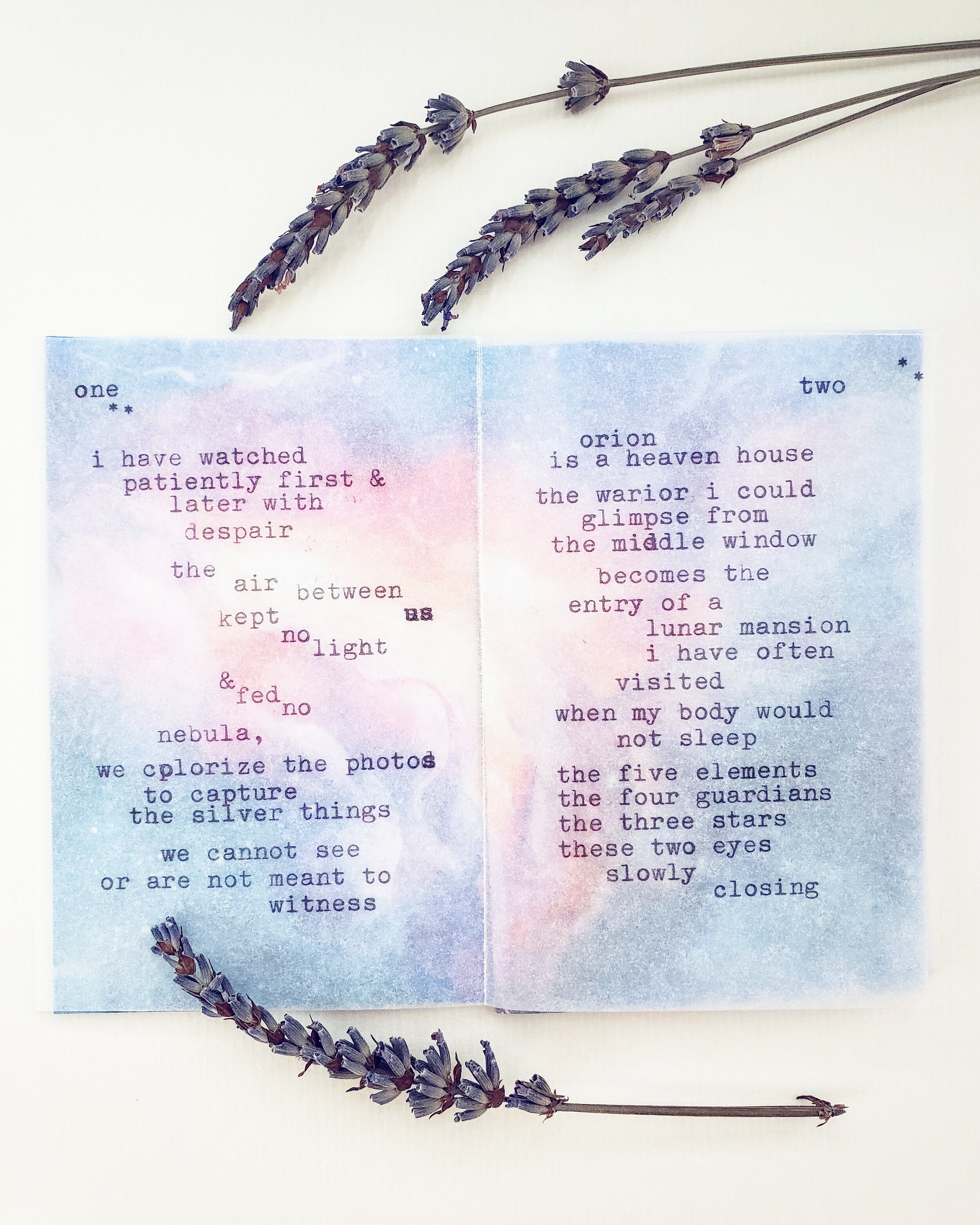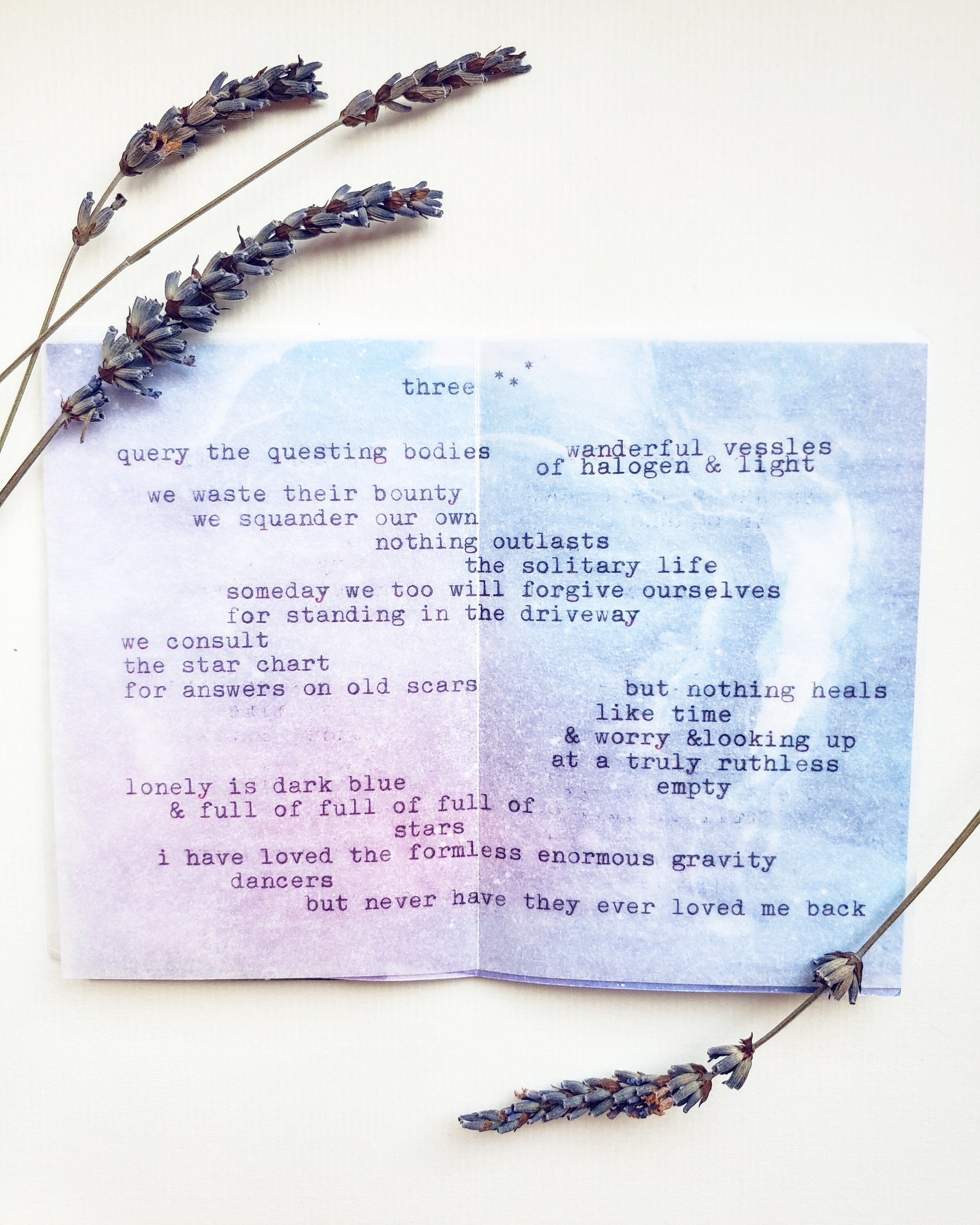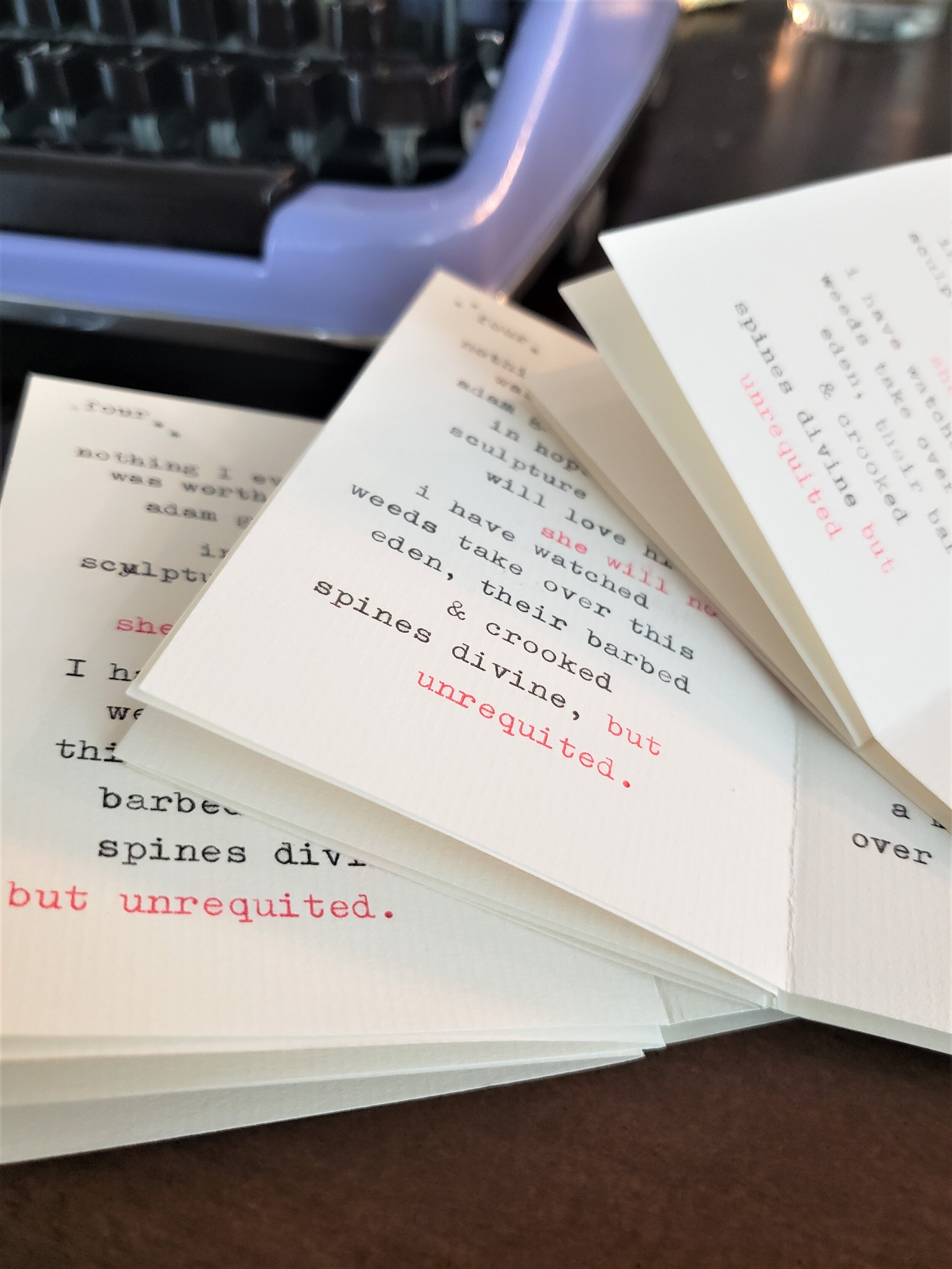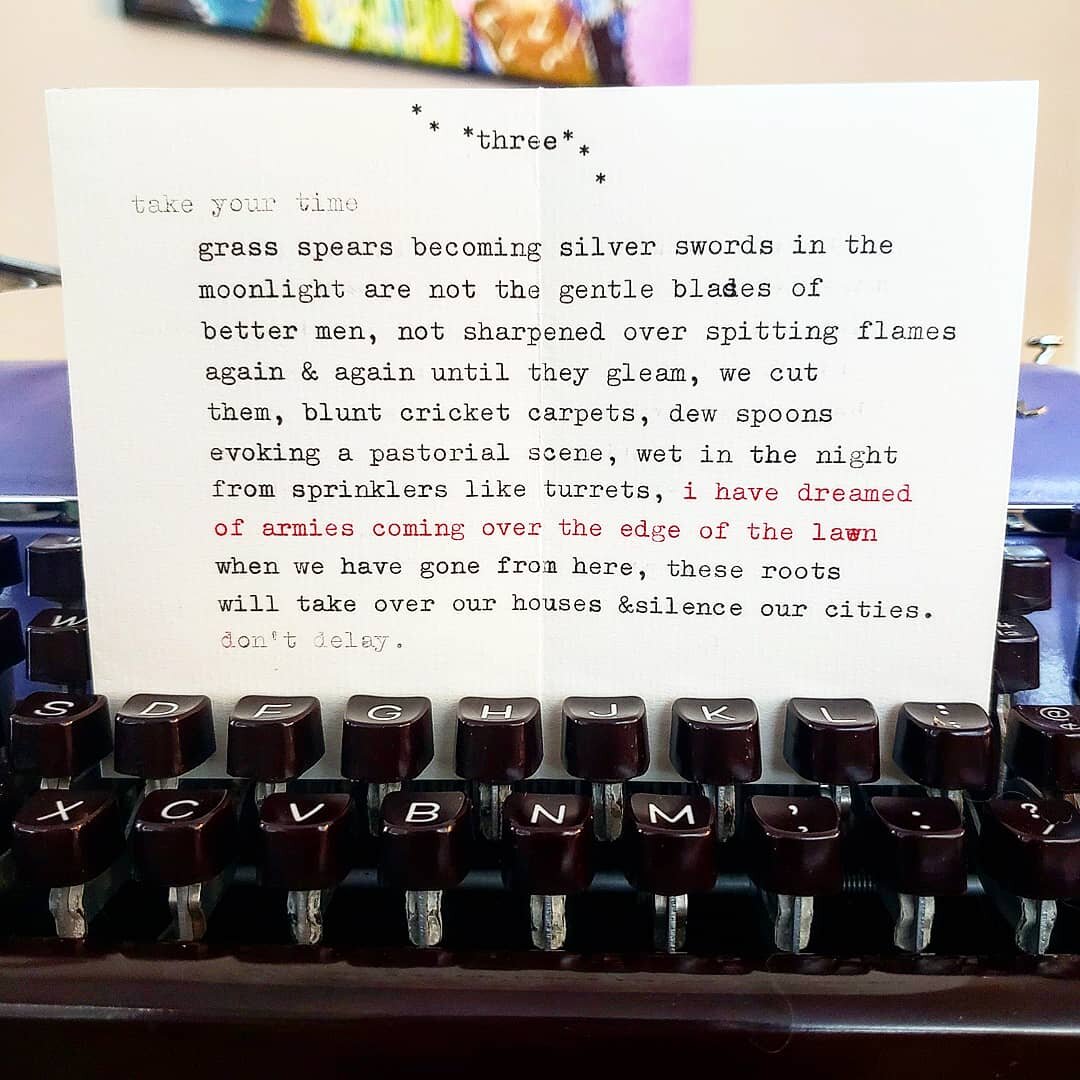During Quarantine, We Made Zines
Photos/Emilee Wirshing.
By Emilee Wirshing
A single sheet of paper has the potential to be a book, if you fold it right. I am no expert on zines, but I have learned, over the last few months, what it takes to turn something underwhelming into a charming bit of ephemera.
My quarantine started with a text from my boss into our group chat. Mostly emojis from the rest of my team. Some relieved, others worried about what the future might hold. Green Valley Library, along with the other two branches of Henderson Libraries would close, unexpectedly, due to the risk of the COVID-19 virus. Looking back, it was the right move. We give books and get hugs, hardly a socially distanced working arrangement. Still, it felt like a small betrayal to not be considered essential.
The following night I watched the Governor address Nevada from my phone. As I listened to his grave state-of-emergency plans, I typed out a poem on my typewriter. It read like a weighted blanket. I stayed with friends for the first two months. It was a quick decision not to be alone. I packed light: a half-dozen yoga pants, cozy oversized t-shirts, my little red dog, and my vintage Olympia SM3 typewriter. I didn’t know what the spring would offer, but I imagined I would want something more than just an endless binge of television.
March 2020 was one long afternoon; it was always three o’clock, and I could be often found downstairs in the kitchen, grazing. It was spring but it felt like a lazy autumn. I called that time our bummer summer vacation, remembering those tween years where I was stuck inside with nothing but time. I counted my days in projects. I made bookmarks and greeting cards on the typewriter; experimented with typing on magazine pages and other mixed media. My friend, a local tattoo artist, was painting a large portrait in those early weeks. We would set up shop in the living room and make something out of the nothing before us. She layered acrylic mauves and violets onto a face with no features. I clicked little letters into existence on my lavender typewriter. Creating gave us purpose. If that inky black ribbon could move forward, maybe so could we.
At the beginning of April, I started making zines. Mostly they detailed the tedium of living inside. I was attracted to the curious shape of the booklet: how a single fold down the center creates a double-sided page. Most of them were littered with errors. I would begin with a title and type until I ran out of space. Each poem reinvented the idea I started with, page by page. As the summer folded in on itself, we too redefined that time. It was no longer a house arrest but a home-improvement opportunity, an organizational all-nighter, a re-write on the life we let get away from us. Being a millennial means always feeling behind. By May, my temporary roommates and I felt as though we were catching up on all the things we set aside.
The zine does not offer anything extraordinary but uses what already exists in a new perspective. It is at once a single sheet of paper and a four-page book. One sided, but also eight sided. Many of my days in isolation were flat, but some of them were folded over and over and over. We watched the same press conferences three or four times to be sure we heard it all. We debated over the safest ways to buy groceries and pump gas. We habitually checked the World Health Organization’s website, addicted to the terrible news. But then we would turn off our phones, watch Tiger King and eat for the seventh time that day. Smooth out the edges of our panic with homemade waffles.
By June, the library had called staff back to work. We sorted out our curbside services and started offering phone and chat reference. Still, so many questions remained. When would we re-open? What about our services would change for now? How might the libraries be changed forever? Would we eventually offer programming? Are webinars really the best way to get people creating?
I had planned to co-host a Poetry Zine Workshop in April 2020. It was cancelled early in the pandemic, and we had no plans for rescheduling. Heather Lang-Cassera, my friend and community partner, had been hosting Open Mic Nights throughout the closures. They were well-attended and fun, but something about staring at a screen for two hours was tiresome. She suggested we venture out of our comfort zones for the zine project. She wanted to see a more tangible impact on the community than just another video call. We devised a take-away activity, something people could make on their own time, which they still had quite a lot of. We made lists, weighed which pens would be best, ordered copious washi tape and stamps. I designed a few hand-outs for the packets, and we put together 40 kits over a weekend.
The timing was perfect. School was not yet in session, and people were reaching critical boredom. The zine packets were some of the first kits we offered at Henderson Libraries. All 40 Make-Your-Own Zine kits were snatched up within a matter of days. We panicked a little, ran the numbers again, and compiled 80 more kits. It was a risk; usually we design programs for smaller audiences, but it felt important to give people what they wanted. The second batch went slower, but after a few weeks, all 120 of the kits were gone.
At the same time, I was working on building a small social following for my typewriter. Every day I posted a little something on Instagram, a tiny gallery of my progress in isolation. By the time we introduced the zine kits to southern Nevada, I had a modest international following. Part of our plan was to reach new community members. We knew library patrons would enjoy zines, and we were certain the poets in the valley would jump right in, but we wanted to invite new faces to the virtual table. Heather and I offered to share what people had made via social media. It seemed like an afterthought at the time. In a programming setting, the sharing is part of the package, but online it’s more isolated. We just wanted people to know we cared about what they were making with the kits.
We reposted, tagged, and gushed over what Nevadans were creating at home. To get more involvement, I made a few informative videos on how to fold paper for zine blanks and how to use what we offered in the packets. The content took off. Poets from London, England to Sydney, Australia reached out and sent me photos of their zines. One writer even made it onto his local news channel for the zines he was hiding in a city-wide scavenger hunt. Zine publishers and at-home hobbyists shared their latest creations with Heather and me online. It felt for a moment like we were a community again. A bigger one, with new faces and fresh stories to tell.
Not much about 2020 has been ideal. We have suffered losses beyond calibration. We stayed home, in hopes that this would keep us safe. We felt alone, small, sometimes insignificant in a world beyond our control. But I have learned that in these spaces, there is grace. We have the opportunity to restructure who we are and what we make of it. During my quarantine, I made zines. Pocket-sized time capsules of a world outside of ordinary. I would change so much about this past year, but I am grateful we needed to adapt. I feel fortunate that in cancelling our in-person workshop we were able to reach hundreds more with our invitation to create.
Time at school, years spent in various jobs, these are the chapters of a life. But our months at home hardly feel like a chapter in my biography. It’s not important enough to have it’s own space in my identity and yet my half-year in waiting changed so much of who I am. Perhaps this pause in reality, our bummer summer vacation is less of a whole chapter, and more of a zine. A tidy little pamphlet, written on a vintage typewriter, with no need to be part of the overarching story. Just a piece of impossibility, tucked between the pages.






Emilee Wirshing is a librarian and lifelong Nevadan. She advocates for local poets and creativity by hosting various Poetry Open Mic Nights and writing workshops in the community. Her work appears in anthologies Clark, Legs of Tumbleweed, Wings of Lace, and Sandstone & Silver, along with various local and national literary mags. Her chapbook, american dream houses was published in March 2020 by Tolsun Books.
Emilee’s typewriter poetry can be found in Instagram: @lavendertypewriter.
Thank you for visiting Humanities Heart to Heart, a program of Nevada Humanities. Any views or opinions represented in posts or content on the Humanities Heart to Heart webpage are personal and belong solely to the author or contributor and do not represent those of Nevada Humanities, its staff, or any donor, partner, or affiliated organization, unless explicitly stated. At no time are these posts understood to promote particular political, religious, or ideological points of view; advocate for a particular program or social or political action; or support specific public policies or legislation on behalf of Nevada Humanities, its staff, any donor, partner, or affiliated organization. Omissions, errors, or mistakes are entirely unintentional. Nevada Humanities makes no representations as to the accuracy or completeness of any information on these posts or found by following any link embedded in these posts. Nevada Humanities reserves the right to alter, update, or remove content on the Humanities Heart to Heart webpage at any time.



